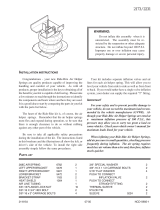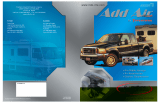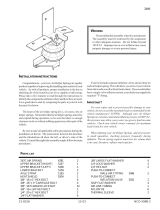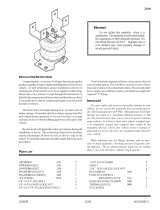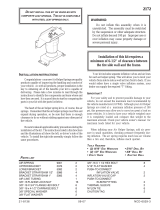Page is loading ...

RR 2068
INSTALLATION INSTRUCTIONS
Congratulations - your new Ride-Rite Air Helper
Springs are quality products capable of improving the
handling and comfort of your vehicle. As with all
products, proper installation is the key to obtaining all of
the benefits your kit is capable of delivering. Please take
a few minutes to read through the instructions to identify
the components and learn where and how they are used.
It is a good idea to start by comparing the parts in your kit
with the parts list below.
The heart of the Ride-Rite kit is, of course, the air
helper springs. Remember that the air helper springs
must flex and expand during operation, so be sure that
there is enough clearance to do so without rubbing
against any other part of the vehicle.
Be sure to take all applicable safety precautions
during the installation of the kit. The instructions listed
in this brochure and the illustrations all show the left, or
driver’s side of the vehicle. To install the right side
assembly simply follow the same procedures.
Your kit includes separate inflation valves and air
lines for each air helper spring. This will allow you to
level your vehicle from side to side as well as from front
to back. If you would rather have a single valve inflation
system, your dealer can supply the required "T" fitting.
IMPORTANT!
For your safety and to prevent possible damage to
your vehicle, do not exceed the maximum load recom-
mended by the vehicle manufacturer (GVWR). Al-
though your Ride-Rite Air Helper Springs are rated at
a maximum inflation pressure of 100 P.S.I., this
pressure may allow you to carry too great a load on
some vehicles. Check your vehicle owner’s manual for
maximum loads listed for your vehicle.
When inflating your Ride-Rite Air Helper Springs,
add air pressure in small quantities, checking pressure
frequently during inflation. The air spring requires
much less air volume than a tire and, therefore, inflates
much quicker.
WARNING:
Do not inflate this assembly when it is
unrestricted. The assembly must be re-
stricted by the suspension or other adequate
structure. Do not inflate beyond 100 P.S.I.
Improper use or over inflation may cause
property damage or severe personal injury.
Firestone Industrial Products
Carmel, Indiana, USA
21-8071 06-98 NCD-5016-3
224C AIR SPRING 0335 2
UPPER BRACKET 5090 2
LOWER BRACKET 5220 2
BRACKET STRAP 5103 2
AIR LINE TUBING 1
3/8"-24 FLANGE NUT 4
3/8"-16 FLANGE LOCK NUT 12
3/8"-16 X 3/4" HEX BOLT 4
3/8"-16 x 5-1/2" CARRIAGE BOLTS 4
3/8" SPECIAL WASHER 8
3/8"-16 X 1 1/2 HEX BOLT 8
5/16" FLAT WASHER 4
PUSH TO CONNECT
INFLATION VALVE 3032 2
PUSH TO CONNECT
ELBOW FITTING 3031 2
THERMAL SLEEVE 0899 2
NYLON TIE 6
PARTS LIST

K
I
T
A
S
S
E
M
B
L
Y
RR 2068
3/8"-16
HEX NUT
UPPER BRACKET
AIR SPRING
LOWER
BRACKET
AIRLINE TUBING
3/8"-16
HEX NUT
ASSEMBLED AIR SPRING KIT
Figure A
KIT TO FRAME ASSEMBLY
FRAME
LEAF SPRING
3/8"-16 x 1 1/2
HEX BOLT
3/8"-16 X 1"
HEX BOLTS
AIR FITTING
LARGE FLAT
WASHERS
NOTE: Both illustrations are of the left, or drivers
side, of the vehicle. Reverse any orientations when
assembling and installing the right, or passenger, side
of the vehicle.
FRONT
WHEEL
LARGE FLAT
WASHERS
HOLES TO BE DRILLED 7/16"
3/8" -16 x 4"
CARRIAGE BOLT
BRACKET
STRAP
3/8" -16 FLANGE
LOCK NUTS
3/8"-16 x 1 1/2
HEX BOLT
EXISTING HOLES
TM TM
R

LOWER BRACKET
LEAF SPRING STACK
AXLE
FRONT
Left side shown
(Drivers side)
JOUNCE BUMPER
EXISTING 5/8 DIA. HOLE
HOLE TO BE DRILLED
HOLE TO BE DRILLED
EXISTING 5/16 DIA. HOLE
AIR HOSE
INFLATION
VALVES
BUMPER
AIR
SPRINGS
STEP 1 - PREPARE THE VEHICLE
Make sure that the vehicle is on a solid
level surface. Take necessary safety pre-
cautions such as using wheel chocks when
working under your vehicle. This vehicle
does not have to be jacked up to install the
kit. Remove the positive battery cable.
STEP 2 - PREASSEMBLE THE
RIDE-RITE KIT
Select one air helper spring from your
kit and an upper bracket. Align the studs
on the air spring with the holes on the
upper bracket making sure the air inlet
hole can be seen through the slot in the
upper bracket see Figure "A". Use the
3/8"-16 flange lock nuts to secure the up-
per bracket to the air spring. Install the air
fitting as shown in Figure "A". Tighten the
air fitting securely to engage the orange thread sealant. Point the
elbow fitting in the direction of the inflation valve location. Refer to
Step 6 for inflation valve installation. Position the lower bracket as
shown in Figure "A" & "B". Fasten the lower bracket to the air helper
spring using two 3/8"-16 x 3/4" hex bolts.
STEP 3 - PRE-FIT MARK AND DRILL HOLES
Position the assembly on the frame as shown in Figure "A" & "B".
The upper bracket has three holes in each flange. Only two holes in
each flange will be used for mounting to the frame. Two mounting
holes are matched with existing holes in the frame see Figure "A" &
"B". One hole is 5/16" in diameter and will need to be drilled out using
a 7/16" diameter drill bit. Before drilling the holes make sure all
electrical, brake and fuel lines are cleared from the path of the drill.
Damage to lines can be avoided by inserting a piece of wood between
the frame rail and any lines in the path of the drill. The other hole is
5/8" diameter and will require the use of a 3/8" special washer behind
the frame rail. The 3/8" diameter washers should also be placed on the
inside of the frame rail behind each upper bracket fastener. Bolt the
upper bracket to the existing holes in the frame as shown in Figure
"A". Using the bracket as a template drill a 7/16" hole in each of the
upper flange holes shown in Figure "A" & "B". Complete the attachment
of the upper bracket to the frame using the 3/8"-16 x 1-1/2" hex bolts,
washers and nuts.
STEP 4 - LOWER BRACKET ATTACHMENT
Mount the lower bracket to the leaf spring stack by sliding the lower
bracket to the leaf spring retainer see Figure "B". Make sure the lower
bracket is placed so that the retainer and leaf spring "U"-bolt is captured
by the lower bracket as shown in Figure "B". Install 3/8"-16 x 5-1/2"
carriage bolts in the square holes of the lower bracket. The lower bracket
is then secured by a bracket strap which is placed under the leaf spring
stack and retained with 3/8"-16 flanged lock nuts.
STEP 5 - INSTALLATION TO THE PASSENGER'S SIDE ASSEMBLY
Follow steps 1-4 for assembly and installation of the passenger's
side assembly. Reverse any orientations when assembling and in-
stalling the right, or passenger, side of the vehicle. Please note that
when installing the kit on the passenger's side of the vehicle, the upper
bracket will locate again on the existing holes in the frame. However,
Figure "B"
AIR HOSE
PUSH-TO-CONNECT
INFLATION VALVE
FLAT WASHER
HEX NUT
VALVE CAP
BODY OF
VEHICLE
Figure "D"
Figure "C"
NOTE:
Once the air helper springs are
installed, it is recommended that the
vehicle not be lifted by the frame, as
over-extension may occur, resulting in
damage to the air helper springs. How-
ever, should it become necessary to raise
the vehicle by the frame, deflate both air
helper springs completely.

FIRESTONE INDUSTRIAL PRODUCTS CARMEL, INDIANA 46032
TELEPHONE: 317-818-8600 TELEPHONE: 1-800-247-4337 FAX 317-818-8645
www.firestoneindustrial.com
one existing frame hole must be drilled out to bolt the upper bracket tp the frame due to a heat shield covering the hole
from the inside of the vehicle frame. This heat shield material must be removed using a 7/16" drill bit to allow the fastener
to pass through the hole.
STEP 6 - INSTALL THE AIR LINE AND THE INFLATION VALVE
Uncoil the air line tubing and cut it into two equal lengths. DO NOT FOLD OR KINK THE TUBING. Try to make the
cut as square as possible. Insert one end of the tubing into the elbow fitting installed in the top of the air helper spring. Push
the tubing into the fitting as far as possible refer to Figure "A".
Select a location on the vehicle for the air inflation valves. The location can be on the bumper or the body of the vehicle,
as long as it is in a protected location so the valve will not be damaged, but maintain accessibility for the air chuck see Figure
"C". Drill a 5/16" hole and install the air inflation valve using two 5/16" flat washers per valve as supports see Figure "D".
Run the tubing from the air helper spring to the inflation valve, routing it to avoid direct heat from the engine, exhaust pipe,
and away from sharp edges. Thermal sleeves have been provided for these conditions. If a thermal sleeve is required simply
slide the sleeve over the air line tubing to the location requiring protection. The air line tubing should not be bent or curved
sharply as it may buckle. Secure the tubing in place with the nylon ties provided. Push the end of the air line tubing into the
inflation valve as illustrated see Figure "D".
STEP 7 - CHECK THE AIR SYSTEM
Once the inflation valves are installed inflate the air helper springs to 70 P.S.I. and check the fittings for air leaks with
an applied solution of soap and water. If a leak is detected at a tubing connection then check to make sure that the tube is
cut as square as possible and that it is pushed completely into the fitting. The tubing can easily be removed from the fittings
by pushing the collar towards the body of the fitting and then pulling out the tube. If a leak is detected where the brass elbow
fitting screws into the spring, remove the tubing (see trouble shooting section of the operating instruction manual for removal
procedure),then screw the elbow into the air spring one additional turn or until the leak stops. Reinstall the tubing and reinflate
the air springs and check for leaks as noted above. Further information on trouble-shooting can be found in the General
Operation Instruction book included with this kit.
This now completes the installation. Re-attach the postive battery cable and remove the wheel chocks from the rear wheels.
Before proceeding, check once again to be sure you have proper clearance around the air springs. With a load on your vehicle
and the air helper springs inflated, you must have at least 1/2" clearance around the air springs. As a general rule, the Ride-Rite
Air Helper Springs will support approximately 50 lbs. of load for each P.S.I. of inflation pressure (per pair). For example, 50
P.S.I. of inflation pressure will support a load of 2500 lbs. per pair of air helper springs. FOR BEST RIDE use only enough air
pressure in the air helper springs to level the vehicle when viewed from the side (front to rear). This amount will vary depending
on the load, location of load, condition of existing suspension and personal preference.
NOTE:
Too much air pressure in the air helper springs will result in a firmer ride, while too little air pressure will allow the air
helper spring to bottom out over rough conditions. Too little air pressure will also not provide the improvement in handling
that is possible. TO PREVENT POSSIBLE DAMAGE MAINTAIN A MINIMUM OF 20 P.S.I. IN THE RIDE-RITE AIR
HELPER SPRINGS AT ALL TIMES.
Enclosed with this kit are Ride-Rite Operating Instructions. Please read them for proper and safe operation.
Optional Air Convenience
Systems Available
Providing instant air supply and
air pressure adjustment.
For more information on air convenience systems, contact your dealer or Firestone at 1-800-247-4337
The air convenience system can be easily added to your existing Ride-Rite kit by re-routing the air line tubing.
0 150
30
120
60 90
200
400
600
800
1000
psi
kPa
PSI
/
